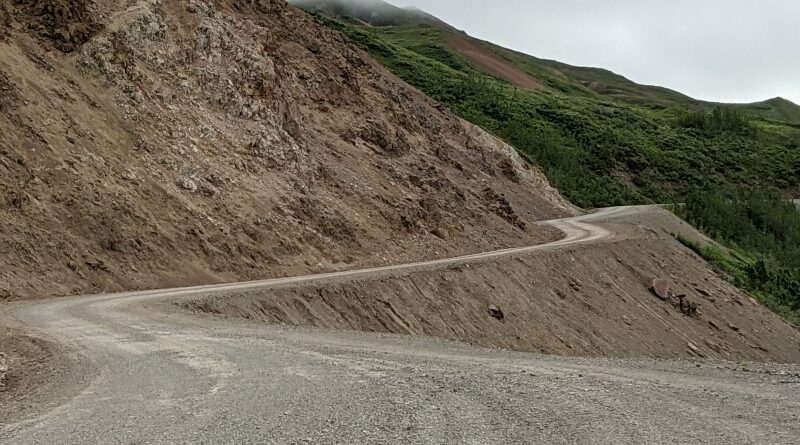Fragility

Part 5 of a Series – see Series Introduction here
The Denali park road has always been fragile. I was struck at the DCC annual meeting by the descriptions given by long-time road crew folks like Brad Ebel and Jeff Craig of all the work it takes to maintain a gravel road deep into the wilderness. The road is always falling apart, the surface constantly eroding and being chewed away at the edges. Only the constant application of energy and new gravel keeps it drive-able. Heavier buses and higher traffic volumes accelerate the crumbling beyond historic norms.
Climate change has starkly revealed the fragility to those of us unaware or only casually aware of the heroic maintenance effort taking place in the background. Melting ice in places long-frozen is causing new problems for the structure of the road. Pretty Rocks is the most dramatic example, but agency reports outline dozens of potential problem areas along the road’s length. In context, the bridge under construction at Pretty Rocks is like a single stitch attempting to hold together a fraying garment that will continue to fall apart beyond the anchors of the sturdy new thread. And the anchors themselves are more fragile than the buttresses of other park bridges, requiring a technological fix to keep the ground frozen underneath. NPS now has committed at least $130 million to this one stitch in the fabric of the park road.
All human infrastructure is fragile and fleeting when viewed across geologic time spans, but the park road is fragile even when viewed over the course of a decade, or a year. I have long advocated for preserving the road’s historic character, and the opportunity to travel a primitive road into the heart of the Denali wilderness, which I personally value. However, the Pretty Rocks bridge is likely to be just one of an accelerating number of compromises to this historic feature, following on many accumulated prior compromises. Increasing numbers of stitches will be required in the future, threatening to turn the road corridor into a perpetual construction zone where it will be challenging for visitors to connect with either the wilderness or the wildlife they came to see. Arguably, some past seasons have already faced this challenge.
We must ask: can the historic park road and its associated visitor experience be sustained in an era of increased landscape change and increased visitor demand? There may be a fundamental mismatch between the historic road we have and the demands that modern traffic and climate place upon it.
Instead of spending hundreds of millions of dollars trying to hold together the road across its entire length, perhaps we should instead think more expansively. Is there a different or better way for most visitors to experience Denali? Is there more robust infrastructure that we should spend those hundreds of millions of dollars on instead of the road? Should we recalibrate road usage to create a better match between the structure of the road and the number and weight of vehicles using it, keeping in mind the effects of a changing climate?
I fear that we are drifting into a future where we dribble increasing amounts of money into ever-more frequent construction projects to accommodate heavier traffic while the qualities that make the road special – the primitive feel, the immersion in a wilderness landscape, the proximate wildlife – all fade away amidst the hubbub. We need to get to a place where instead of just frantically putting in stitches to prevent the road from unraveling, we are actually knitting together something beautiful.
Charlie Loeb first came to Denali in 1988 as a volunteer interpretive ranger, and went on to manage the Denali branch of the Alaska Natural History Association (now Alaska Geographic), work as a NPS planner, and manage Talkeetna Community Radio among many other roles. He has served on the DCC board of directors since 2017 after a previous stint from 2011-2014.



So well said.
Thanks for this eye-opening article to someone who lives in Los Angeles! $130 million for a band-aid approach that won’t even hold for long is untenable. In our area, over $25 million has been spent on a wildlife bridge over a major freeway to help our wildlife exist in this urban/wilderness conflict. That now seems like a bargain compared to what costs are in Alaska! I’m curious what would be an alternative to the road into Denali if it is no longer feasible?
PS Remember meeting Charlie in Ireland in 2012 which started my interest in the Denali Citizens Council!
Great to hear from you Kris! It is worth keeping in mind that $130 million is the last figure NPS communicated directly to DCC, and the Anchorage Daily News cited $150 million in one article. The project still has 2 full years to go, and it would hardly be unusual for the cost to increase as it already did earlier this year. Denali is a very expensive place for construction, but at some point the cost starts looking too absurd.
I am personally very open to a discussion about alternatives, although any suggestion will be met with a barrage of objections. For example, there is an already approved plan to build a joint federal-state visitor center in Denali State Park in a place that has spectacular views of Denali and the Alaska Range, albeit without the foreground framing one gets from Stony Hill and Eielson. The site is near to the Parks Highway with most of the access road already built. Could that facility be a reasonable alternative to Eielson for most Denali visitors, and at much less cost than the bridge? Let the objections begin! I have objections myself, and I do realize the park road provides access to much more than just the view at Eielson. But what is the best value we can get for park visitors per dollar of infrastructure investment? And what is best for wildlife, the wilderness, the planet? I do think we should be considering alternatives, for reasons expressed above and in some of the other essays. We last took a big-picture look at the future of visitation in Denali back in the General Management Plan amendments of 1997 (South Denali plan, Entrance Area/Frontcountry plan) – more than a quarter century ago. A lot has changed since then, and we know a lot more too. It is time to take another look in which maintaining the park road for heavy bus traffic is one alternative among many.
Remember the Alaska pipeline?
That project went 7 billion over budget
I will bet the cost of the bridge will double, if it even gets completed
To everyone at DCC – Thank you for these thought provoking essays, I enjoyed reading each of them.